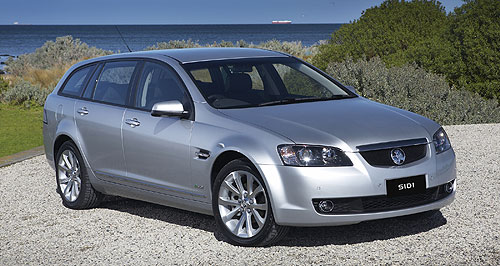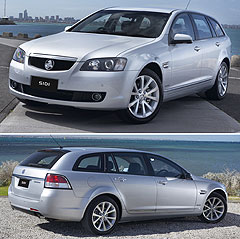First drive: Holden V6 keeps evolving
BY BYRON MATHIOUDAKIS | 8th Sep 2009

The larger of the new V6 duo is next in line to adopt some of the advances introduced in the newer ‘One-Plus’ generation 3.0-litre SIDI V6 powering the bottom-end VEs.
Expected to debut “in the not too distant future”, according to one Holden source (although whether this means it arrives with next year’s ‘VF’ series facelift is unclear), the upcoming ‘One-Plus’ 3.6 SIDI V6 is set to ditch the just-released 3.6 SIDI V6’s carryover Alloytec cast iron external manifold for a variation of the 3.0-litre’s lighter composite intake manifold and integrated exhaust manifold.
As with the smaller V6, this move eliminates the need for a separate component, and should bring benefits such as falls in fuel consumption and carbon dioxide emissions, thanks to a drop in mass as well as quicker-acting catalytic converter light-off operation. The manifold redesign would build on the efficiency improvements gained by the just-announced 3.6L SIDI V6 powering the MY10 VE SV6 sedan, Sportwagon and utility, and Calais sedan and Sportwagon, as well as the WM Statesman and Caprice long-wheelbase series.

In a nutshell, Holden says, less fuel is required to produce the equivalent power, particularly at normal cruising speeds, compared with the outgoing 3.6-litre Alloytec’s conventional port-injection combustion system. Also new is a revised engine control module, using torque-based control strategies and including special drivers to operate the higher-voltage direct injectors. This ECU oversees the cam phasing, electronic throttle control, traction control and ESP, ‘returnless’ fuel injection system with injection and spark timing adjustments for various grades of fuel, and ‘limp-home’ mode.
It also continues to control the ignition timing device should there be a sensor failure, and also provides coolant loss protection by allowing the 3.6L SIDI V6 to run safely at reduced power until a secure location is reached.
Like its 3.0 sibling, the 3.6 V6 was jointly developed by Holden in Melbourne, along with GM in North America and Germany.
Holden says calibration work commenced in early 2007, involving more than 1.1 million test kilometres and almost 11,000 engine dynamometer hours. Another 300,000 kilometres oversaw full systems integration and component durability testing.
The outcome is a Euro 4-plus emissions-compliant 3.0-litre SIDI V6 producing 190kW at 6700rpm and 290Nm of torque from 2900rpm on the base cars, compared with the previous base 3.6-litre Alloytec’s 180kW and 330Nm (the LPG version continues with 175kW/325Nm).
Moving up to the 3.6L SIDI V6, it delivers 210kW at 6400rpm (the most power for a naturally aspirated Australian produced car) and 350Nm at 2900rpm – up from the up-spec V6’s 195kW/340Nm.
Operating on standard 91 RON unleaded petrol, the latter’s fuel economy savings are between seven and 13 per cent.
The SV6 sedan can achieve 10.2L/100km, down from 11L/100km, the SV6 Ute drops from 11.6 to 10.1L/100km, the MY10 WM Statesman and Caprice V6s drops to 10.3L/100km – down from 11.5L/100km – and the Calais falls from 11.2 to 9.9L/100km.
On the CO2 front, emissions ratings slide by between seven per cent (242 grams per kilometre for the SV6 sedan with a six-speed manual gearbox) and 12 per cent (SV6 auto utility: 241g/km), with 245g/km being the highest among the 3.6 SIDI V6 models.
SV6 manual aside (which now benefits from a new 257mm higher clamp-load clutch), the standard transmission is GM’s 6L50 six-speed automatic gearbox. A development of the 6L80 paired with the Gen IV V8s since the VE’s launch in 2006, it brings better refinement, performance and shift feel. Its repertoire includes multiple shift patterns – normal auto, sport auto and sequential shift – as well as an adaptive mode called “Performance Mode Lift Foot” that senses sportier driving and either holds a gear for longer or selects a lower gear, an automatic grade braking function that chooses a lower gear and a reverse lockout. Aiding the 3.6 SIDI V6 to be more fuel efficient and lower emissions compliant are innovations such as ‘deceleration fuel cut’ that stops fuel supply seamlessly and in sequence when coasting lower-rolling-resistance tyres that also happen to be 2kg lighter per tyre a 50rpm lower idling speed (to 550rpm) a lighter and more efficient alternator regulated voltage control that monitors the battery’s charge and cuts wasteful electricity loads to the generator and a ‘Turbine Damper’ that – among other duties – smoothes instabilities to allow the V6 to operate in its most efficient low RPM/high torque range, while providing better torsional vibration isolation between the engine and driveline. The 3.6-litre SIDI V6 was introduced for the Cadillac CTS in 2007, and has since been fitted to a range of vehicles, including the Cadillac STS and Camaro coupe.
Next year there will be flex-fuel E85 ethanol-compatible versions of the new SIDI V6s while both have future-technology adaptations that include plug-in electric hybrids – though the latter is thought to be some time away for the Commodore.
Holden will market all its 3.0 and 3.6 SIDI V6s under the EcoLine banner. The introduction of the new V6 engines has not attracted any funding from the federal government’s Green Car Innovation Fund.